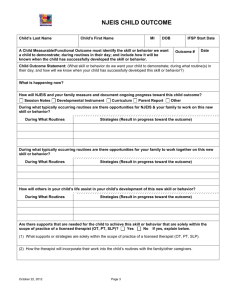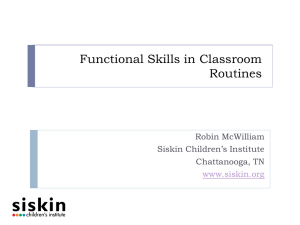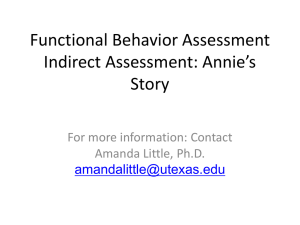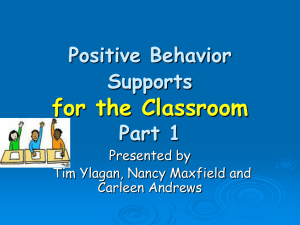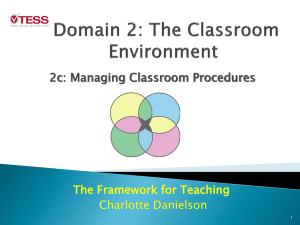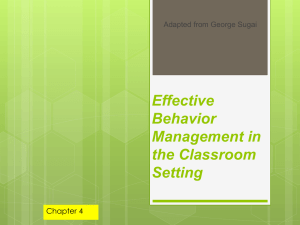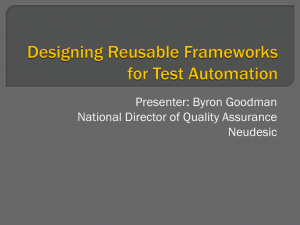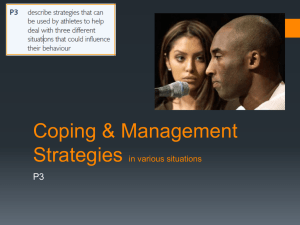TCI-M.-McCoy_Making_..
advertisement
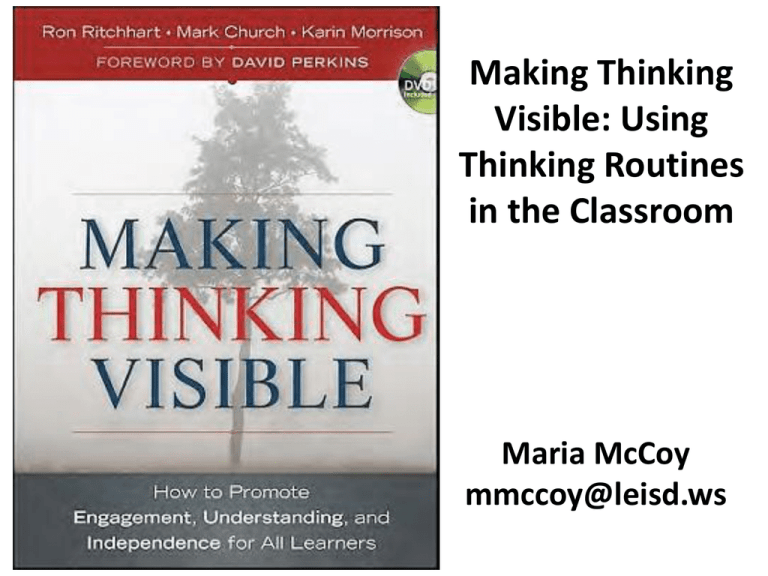
Making Thinking Visible: Using Thinking Routines in the Classroom Maria McCoy mmccoy@leisd.ws Three Ways to Look at Thinking Routines Simple Tools, used in one’s learning to support specific thinking moves. Structures and scaffolds through which we explore, discuss, document, and direct our thinking and learning. Patterns of behavior that we adopt to help us use our minds well in new situations. CHALK TALK Identifying Thinking Recall a lesson or activity you’ve seen that you feel really engaged students in developing understanding. What kinds of thinking did you observe the students engaging in during that activity or lesson? Identifying the Thinking We Value • Generating ideas • Reasoning with evidence • Summarizing • Posing questions • Observing closely • Building explanations • Synthesizing information • Predicting • Evaluating • Visualizing • Analyzing • Making connections • Interpreting & forming conjectures about things • Identifying and exploring multiple perspectives • Looking below the surface of things • Looking for patterns • Clarifying ...and so on. What Kinds of Thinking Do We Value? What does this remind you of? Where else have you seen something like this? How does this connect to the topic you’ve been studying? Where does this fit within the grand scheme of things? What is it like? What is it not like? If you were to group these things, what would go together? What’s a metaphor that might fit this? Routines Sampler • • • • • See-Think-Wonder Zoom In Chalk Talk Headlines Circle of Viewpoints SEE-THINK-WONDER Looking at an image or object: • What do you see? • What do you think is going on? • What does it make you wonder? SEE-THINK-WONDER Steps: • Set up • See • Think • Wonder • Share The Thinking ZOOM IN Look closely at the small bit of image that is revealed: • What do you see or notice? • What is your hypothesis or interpretation of what this might be based on what you are seeing? Reveal More of the Image • What new things do you see? • How does this change your hypothesis or interpretation? Has the new information answered any of your wonders or changed your previous ideas? • What new things are you wondering about? Repeat the Reveal and Questioning Until the Whole Image Has Been Revealed • What lingering questions remain for you about this image? ZOOM IN Steps: • Set up • Reveal • Repeat • Share The Thinking CHALK TALK Looking at the topic or question written on the chart paper: • What ideas come to mind when you consider this idea, question, or problem? • What connections can you make to others’ responses? • What questions arise as you think about the ideas and consider the responses and comments of others? CHALK TALK Steps: • Set up • Present the Chalk Talk Prompt • Circulate • Facilitate • Share the thinking HEADLINES Think of the big ideas and important themes in what you have been learning. • Write a headline for this topic or issue that summarizes and captures a key aspect that you feel is significant and important. HEADLINES Steps: • Set up • Write a headline • Share the thinking • Invite further sharing CIRCLE OF VIEWPOINTS Identify the different perspectives that could be present in or affected by what you have just read, seen, or heard. Record these in a circle with the issue or event at the center. Choose one of these perspectives to explore further, using the following prompts as a starting place: • I am thinking of [name the event/ issue] from the point of view… • I think….[describe the topic from your viewpoint. Be an actor – take on the character of your viewpoint]. Because…[explain your reason] • A question/ concern I have from this viewpoint is … CIRCLE OF VIEWPOINTS Steps: • Set up • Identify viewpoints • Select a viewpoint to explore • Respond to the “I think…” prompt • Respond to the “A question I have from this viewpoint...” prompt • Share the thinking 10 Suggestions for Getting Started with Thinking Routines 1. Have great expectations. Students surprise us daily with their connections, ideas, and the multiple languages they use to make their thinking visible. 2. Do the routines pretty much as is initially. It may feel uncomfortable but wait to see what you learn from using them before adapting them. 3. Match the routines with topics and projects that are significant to students. The routines aren’t the content, they are vehicles for exploring the content. 10 Suggestions for Getting Started with Thinking Routines 4. Model the language for younger and less language able students. Build up the language over time and by modeling your own thinking. 5. Use the language of thinking as often as you can. Name children’s actions like “you made a connection” or “I find your point of view very interesting,” and so on. 6. Document students’ thinking. It send a clear message of how much we value students, their thoughts, and work; and it allows revisiting, reflecting on and re-enforcing the topics later. 10 Suggestions for Getting Started with Thinking Routines 7. Give yourself permission to be a learner and experiment with the routines in a variety of ways. 8. Understand this is a process that takes time. Be patient, consistent and a risk taker. 9. Focus on the thinking you want to promote and why it is important. This will help you attend to students‘ thinking as it emerges. 10. Include parents in the process, they are your allies and it is amazing how they become the first advocates for the use of thinking language at home. “At the core of Visible Thinking are practices that help make thinking visible: Thinking Routines loosely guide learners’ thought processes and encourage active processing. They are short, easy-to-learn mini-strategies that extend and deepen students’ thinking and become part of the fabric of everyday classroom life.” (pzweb.harvard.edu) RESOURCES • Project Zero http://www.pz.harvard.edu/ • Making Learning Visible www.mlvpz.org • Visible Thinking www.visiblethinkingpz.org

